Sony PCS-1-1P User Manual

3-207-456-13 (1)
Video
Communication
System
Operating Instructions
Before operating the unit, please read this manual thoroughly and retain it for future reference.
PCS-1/1P
© 2003 Sony Corporation

Owner’s Record
The model and the serial numbers are located at the bottom. Record the serial number in the space provided below. Refer to these numbers whenever you call upon your Sony dealer regarding this product.
Model No. PCS-1/1P
Serial No. ______________
WARNING
To prevent fire or shock hazard, do not expose the unit to rain or moisture.
To avoid electrical shock, do not open the cabinet. Refer servicing to qualified personnel only.
WARNING
This unit has no power switch.
When installing the unit, incorporate a readily accessible disconnect device in the fixed wiring, or connect the power cord to socket-outlet which must be provided near the unit and easily accessible.
If a fault should occur during operation of the unit, operate the disconnect device to switch the power supply off, or disconnect the power cord.
IMPORTANT
The nameplate is located on the bottom.
For the customers in the USA
WARNING
Using this unit at a voltage other than 120 V may require the use of a different line cord or attachment plug, or both. To reduce the risk of fire or electric shock, refer servicing to qualified service personnel.
This device complies with Part 15 of the FCC Rules.
Operation is subject to the following two conditions: (1) This device may not cause harmful interference, and (2) this device must accept any interference received, including interference that may cause undesired operation.
This equipment has been tested and found to comply with the limits for a Class A digital device, pursuant to Part 15 of the FCC Rules. These limits are designed to provide reasonable protection against harmful interference when the equipment is operated in a commercial environment. This equipment generates, uses and can radiate radio frequency energy and, if not installed and used in accordance with the instruction manual, may cause harmful interference to radio communications. Operation of this equipment in a residential area is likely to cause harmful interference in which case the user will be required to correct the interference at his own expense.
You are cautioned that any changes or modifications not expressly approved in this manual could void your authority to operate this equipment.
The shielded interface cable recommended in this manual must be used with this equipment in order to comply with the limits for a computing device pursuant to Subpart B of Part 15 of FCC Rules.
This manual focuses on using ISDN lines to conduct a videoconference, but it also covers non-ISDN lines. If you use ISDN lines, consult your Sony dealer for more information.
•The ISDN service may not be available in some areas.
Voor de klanten in Nederland
Dit apparaat bevat een vast ingebouwde batterij die niet vervangen hoeft te worden tijdens de levensduur van het apparaat.
Raadpleeg uw leverancier indien de batterij toch vervangen moet worden.
De batterij mag alleen vervangen worden door vakbekwaam servicepersoneel.
2

Gooi de batterij niet weg maar lever deze in als klein chemisch afval (KCA).
Lever het apparaat aan het einde van de levensduur in voor recycling, de batterij zal dan op correcte wijze verwerkt worden.
If you dispose the unit, consult your nearest Sony Service Center. The built-in battery must be treated as a chemical waste.
For the customers in Canada
This Class A digital apparatus complies with Canadian ICES-003.
3

Table of Contents |
|
Chapter 1: Installation and |
|
Preparation |
|
Using This Manual ............................. |
8 |
Features .............................................. |
9 |
System Components ........................ |
11 |
Basic System Components ......... |
11 |
Optional Equipment ................... |
12 |
System Configuration ...................... |
14 |
System Configuration via a |
|
LAN ................................ |
14 |
System Configuration via an |
|
ISDN ............................... |
15 |
System Configuration via a LAN for |
|
Multipoint Conference .... |
16 |
System Configuration via an ISDN |
|
for Multipoint |
|
Conference ...................... |
17 |
System Configuration via a LAN |
|
and ISDN for Multipoint |
|
Conference ...................... |
18 |
System Configuration via a LAN for |
|
Multipoint Data |
|
Conference ...................... |
19 |
System Configuration via an ISDN |
|
for Multipoint Data |
|
Conference ...................... |
20 |
System Connections ......................... |
21 |
System Connection via a LAN ... |
21 |
System Connection via an ISDN 22 |
|
Preparing the System ....................... |
23 |
Inserting Batteries into the Remote |
|
Commander ..................... |
23 |
Turning On/Off the TV Monitor |
|
Together With the |
|
Communication Terminal 24 |
|
Turning the System On/Off ............. |
25 |
Turning On ................................. |
25 |
Standby Mode Function ............. |
26 |
Setting the Video Communication
System to Standby Mode .27
Turning Off ................................. |
28 |
Adjusting the Volume on the TV |
|
Monitor ............................ |
28 |
Displaying the Help .................... |
29 |
Displaying the Versions and |
|
Options ............................ |
29 |
Setting Up the System for the First Time |
|
— Initial Setup Wizard ..................... |
30 |
Using the Menu ................................ |
33 |
Operation .................................... |
33 |
Menu Configurations .................. |
34 |
Entering Characters .................... |
37 |
Chapter 2: Registration and Setup for System Administrators
Registering Local Information ......... |
38 |
Opening the Setup Menu for the |
|
Administrator ................... |
38 |
Dial Setup Menu ......................... |
39 |
Answer Setup Menu ................... |
42 |
Multipoint Setup Menu ............... |
44 |
Audio Setup Menu ...................... |
46 |
General Setup Menu ................... |
47 |
Administrator Setup Menu ......... |
50 |
ISDN Setup Menu ....................... |
51 |
SPID Setting for Customers in the |
|
USA and Canada ............. |
52 |
LAN Setup Menu ........................ |
54 |
Machine Information Menu ........ |
57 |
Status Menu ................................ |
58 |
Encryption via LAN Menu ......... |
60 |
Registering a Remote Party – Phone |
|
Book ................................................ |
60 |
4

Registering a New Remote Party 60 |
|
Changing the Contents of the Phone |
|
Book ................................ |
63 |
Deleting the Registered Remote |
|
Party ................................ |
63 |
Copying the Setting of the Phone |
|
Book Menu ...................... |
64 |
Creating a Private Phone Book .. |
64 |
Chapter 3: Daily |
|
Videoconference |
|
Starting a Conference by Calling a |
|
Remote Party .................................... |
66 |
Turning on the Power ................. |
66 |
Using the Launcher Menu .......... |
67 |
Selecting the Video/Audio Quality |
|
Mode ............................... |
70 |
Calling a Remote Party ............... |
71 |
Receiving a Call from a Remote |
|
Party ............................................... |
78 |
Answering a Call from a Remote |
|
Party ................................ |
78 |
Ending the Conference ............... |
80 |
Adjusting the Sound ......................... |
81 |
Adjusting the Volume ................ |
81 |
Cutting Off the Sound Momentarily |
|
– Muting Function ........... |
81 |
Synchronizing Audio and Video |
|
– Lip Sync Function ........ |
82 |
Reducing Echo – Echo Canceler 82 |
|
Adjusting the Camera ....................... |
83 |
Selecting the Camera to be |
|
Controlled ....................... |
83 |
Adjusting the Camera Angle and |
|
Zoom ............................... |
84 |
Adjusting the Focus and |
|
Brightness ....................... |
86 |
Presetting the Angle and Zoom |
|
Settings ............................ |
87 |
Recalling the Preset Angle and |
|
Zoom Setting .................. |
89 |
Selecting the Input Picture and |
|
Sound ............................................... |
91 |
Switching the Displayed Picture |
|
Between the Local and |
|
Remote Pictures .............. |
91 |
Selecting the Input Picture ......... |
91 |
Switching the Picture Displayed on |
|
the TV Monitor ............... |
93 |
Switching the Sound to Be Sent to |
|
the Remote Party ............ |
93 |
Monitoring the Local Picture as a |
|
Window Picture – PinP Feature ...... |
94 |
Chapter 4: Videoconference |
|
With Optional Equipment |
|
Using Still Images Stored in a “Memory |
|
Stick” for a Videoconference .......... |
95 |
Displaying a Still Image Stored in a |
|
“Memory Stick” .............. |
95 |
Sending a Still Image Stored in a |
|
“Memory Stick” .............. |
98 |
About a “Memory Stick” ............... |
100 |
Formatting a “Memory Stick” . 101 |
|
Sending Motion Pictures as Still |
|
Images ............................................ |
102 |
Sending Still Images Using the Still |
|
Image Menu .................. |
102 |
Sending a Still Image Using the |
|
Communication |
|
Submenu ....................... |
103 |
Sending Motion Pictures Output |
|
from a Document Stand as |
|
Still Images ................... |
104 |
Sending Motion Pictures Input from |
|
an External Camera or Other |
|
Equipment as Still |
|
Images ........................... |
105 |
Receiving Still Images from a Remote |
|
Party ............................................. |
106 |
5

Saving Still Images to a “Memory |
|
Stick” ............................................. |
107 |
Saving Still Images Using the Still |
|
Image Menu .................. |
107 |
Saving Still Images Using the |
|
Memory Stick Menu ..... |
108 |
Saving Still Images Using the |
|
Communication |
|
Submenu ....................... |
109 |
Using a Convenient Menu Available |
|
during Communication — |
|
Communication Submenu .............. |
110 |
Using Two Monitors – Dual |
|
Monitor .......................................... |
111 |
Switching the Picture Displayed on |
|
Dual Monitors ............... |
113 |
Using Multiple Microphones ......... |
114 |
Using the Communication Transducer |
|
(CTE) ............................................. |
116 |
Recording Audio During a |
|
Conference ..................................... |
118 |
Sending Audio/Video from the External |
|
Equipment to a Remote Party ........ |
119 |
Outputting Video Signals to External |
|
Equipment ...................................... |
121 |
Conducting a Conference Without the |
|
Picture – Voice Meeting ................ |
122 |
Controlling the Remote System With |
|
the Tone Signal – DTMF |
|
Transmission .................................. |
123 |
Conducting a Data Conference Using |
|
NetMeeting – T.120 Data |
|
Conference ..................................... |
124 |
Accessing the Communication |
|
Terminal ......................................... |
127 |
Using a Web Browser .............. |
127 |
Using Telnet ............................. |
127 |
Chapter 5: Data Conference |
|
Connection Example Using the Data |
|
Solution Box .................................. |
129 |
To connect the CTE-600 |
|
Communication |
|
Transducer ..................... |
131 |
Using Audio/Video Signal from the |
|
Connected Equipment for a |
|
Conference ...................................... |
132 |
Setting Before Conferencing .... |
132 |
Operating the System During a |
|
Conference ..................... |
132 |
Displaying the Picture on a Projector or |
|
Monitor ........................................... |
136 |
Outputting the Signal to One |
|
Monitor .......................... |
136 |
Outputting the Signal to Two |
|
Monitors ........................ |
137 |
Chapter 6: Videoconference
Using a Whiteboard
Connection Example With a |
|
Whiteboard ..................................... |
139 |
Attaching the mimio Xi on the |
|
Whiteboard ..................................... |
140 |
Conducting a Videoconference Using a |
|
Whiteboard ..................................... |
141 |
Chapter 7: Encrypted Videoconference via LAN
Preparing for an Encrypted |
|
Videoconference via LAN .............. |
145 |
Starting an Encrypted Videoconference |
|
via LAN .......................................... |
146 |
Chapter 8: Multipoint
Videoconference
Connection Examples for a Multipoint
Videoconference ............................. |
148 |
Using the LAN Connection (Up to 6 |
|
Points) ............................ |
148 |
6

Using the Cascade Connection via |
|
LAN (Up to 10 Points) .. 149 |
|
Using the ISDN Connection ..... |
150 |
Using the LAN & ISDN |
|
connections ................... |
152 |
Using the LAN & ISDN cascade |
|
connection ..................... |
153 |
Preparing for a multipoint |
|
videoconference ............................. |
154 |
Installing the MCU software .... |
154 |
Setting the Multipoint Setup |
|
Menu ............................. |
156 |
Registering the Remote Parties in |
|
the Multipoint Connection |
|
List ................................ |
157 |
Starting a Multipoint |
|
Videoconference ............................ |
161 |
Calling Remote Parties ............. |
161 |
Receiving a Call from a Remote |
|
Party .............................. |
165 |
Using the Display Control .............. |
166 |
What is “Broadcast Mode”? ..... |
166 |
Broadcast Modes and Displayed |
|
Windows ....................... |
168 |
Switching the Broadcast Mode . 169 |
|
Receiving the Broadcast Requested |
|
From Any Other |
|
Terminal ........................ |
170 |
Ending the Multipoint |
|
Videoconference ............................ |
171 |
Notes on Secondary Terminals ...... |
172 |
Connecting the External MCU ....... |
173 |
Activating the Chair Control .... |
173 |
Multipoint Attribute ....................... |
176 |
Appendix |
|
Location and Function of Parts and |
|
Controls .......................................... |
178 |
PCS-P1/P1P Communication |
|
Terminal ........................ |
178 |
PCS-C1/C1P Camera Unit ....... |
179 |
PCS-R1 Remote Commander .. |
180 |
PCS-B768 ISDN Unit |
|
(Optional) ..................... |
182 |
PCS-DSB1 Data Solution Box |
|
(Optional) ..................... |
182 |
On Screen Messages ...................... |
184 |
Troubleshooting ............................. |
191 |
Specifications ................................ |
195 |
PCS-P1/P1P Communication |
|
Terminal ....................... |
195 |
PCS-C1/C1P Camera Unit ....... |
196 |
PCS-R1 Remote Commander .. |
196 |
PCS-AC195 AC Adaptor ......... |
196 |
PCS-A1 Microphone |
|
(Optional) ..................... |
196 |
PCS-A300 Microphone |
|
(Optional) ..................... |
197 |
PCS-B768 ISDN Unit |
|
(Optional) ..................... |
197 |
PCS-DSB1 Data Solution Box |
|
(Optional) ..................... |
197 |
PCS-320M1 H.320 MCU Software |
|
(Optional) ..................... |
197 |
PCS-323M1 H.323 MCU Software |
|
(Optional) ..................... |
197 |
Acceptable RGB Input/Output |
|
Signals .......................... |
198 |
Pin Assignment ........................ |
200 |
Pin Assignment on Optional Board |
|
Connectors .................... |
202 |
Videoconferencing Room Layout . 203 |
|
Camera Range .......................... |
203 |
Installing the Communication |
|
Terminal and Camera ... |
204 |
Glossary ......................................... |
205 |
Menu Configuration ...................... |
208 |
7

Chapter 1:
Installation and
Preparation
Using This Manual
The chapters cover the following contents; please read the chapters that may be required for your type of videoconference.
Chapter 1: Installation and Preparation
This chapter guides you through the system configuration and information required to use your Video Communication System for the first time. It shows you how to install and connect your Video Communication System, to turn the system on/off and how to access basic on-screen menus.
Chapter 2: Registration and Setup for System Administrator
This chapter describes how to register and set up all the necessary items for system administrators, using the on-screen menus.
Chapter 3: Daily Videoconference
This chapter guides you through the basic operations and settings to conduct a videoconference. You will learn how to conduct a conference from start to finish. It is recommended that this chapter be read by participants in the videoconference.
Chapter 4: Videoconference With Optional Equipment
This chapter shows advanced videoconferencing using the optional equipment.
Chapter 5: Data Conference
This chapter shows you how to use the data from a computer for the conference by using the optional Data Solution Box.
Chapter 6: Videoconference Using a Whiteboard
This chapter shows how to use a whiteboard with the mimio Xi* attached for a videoconference.
*mimio® is a registered trademark of Virtual Ink Corporation of the United States. minio Xi is a trademark of Virtual Ink Corporation of the United States.
Chapter 7: Encrypted videoconference via LAN
This chapter shows how to conduct a videoconference using an encrypted video and audio data, and encrypted data from a computer connected to the Data Solution Box.
Chapter 8: Multipoint Videoconference
This chapter shows you how to use the Video Communication System to hold a multipoint videoconference.
You need to install MCU software in this System for a multipoint videoconference.
Appendix
This chapter contains description of the controls and connectors on the components of the Video Communication System, message and troubleshooting lists, specifications and glossaries.
8 Using This Manual

Features
The PCS-1/1P Video Communication System is a videoconferencing system that provides natural, face-to-face communications with a remote party by transmitting and receiving images and sound via LAN (Local Area Network) or ISDN (Integrated Services Digital Network) connections.
Supports ITU-T international videoconferencing standard
The Video Communication System complies with ITU-T Recommendations defined by WTSC for easy connection with remote parties overseas.
ITU: International Telecommunication Union
WTSC: World Telecommunications Standardization Committee
Supports data conferences
Use of the optional PCS-DSB1 Data Solution Box allows the data from a personal computer to be incorporated in the presentation or to be shown on the projector.
Versatile use with a variety of display units
The Video Communication System is compact size, allowing easy installation on a TV. The camera and the Communication Terminal can be separately installed, allowing for greater flexibility when using a large-size plasma display, projector screen, etc.
High transmission speeds and high-quality picture capability
The Video Communication System accepts a LAN bandwidth of up to 1920 Kbps. It also allows connection to as many as six ISDN lines; 12B channels usable by using the optional PCS-B768 ISDN Unit.
Wide range of video/audio compression format selectable
The Video Communication System supports Interlaced SIF, H.264, MPEG4, H.263+, H.263 and H.261 for video compression format, and MPEG4 Audio, G.722.1, G.722, G.729, G.728, G.723.1, G.711 for audio compression format. You can choose whether priority is given to video or audio depending on the type of conference or video/audio equipment used by a remote party.
QoS (Quality of Service) function for optimization of bandwidth and traffic packet through network
“Packet Resend Request” and “Adaptive Rate Control” functions incorporated, allowing solution for busy network traffic or packet loss, which provides consistent highquality communication.
Easy setup and operation
The Help menu appears on the monitor screen for guidance of operation. The menus used for the system administrator or those for conference participants are separately displayed.
Supports multipoint conference
Installing the optional PCS-323M1 H.323 MCU software (for LAN) or the PCS320M1 H.320 MCU software (for ISDN) allows conduct of a multipoint conference. The multipoint conference via LAN and ISDN connections mixed is also available if both the PCS-323M1 H.323 and PCS320M1 H.320 MCU software are installed in a main Terminal.
Memory Stick slot equipped
The Communication Terminal is equipped with a Memory Stick slot, allowing the use of still images recorded with a digital still camera and stored in the “Memory Stick”.
Dual monitor system
Two monitors can be connected to the Communication Terminal, enabling the use
Preparation and Installation 1: Chapter
Features 9

of one monitor for motion pictures, and the other monitor for pictures from a computer or still images.
Supports an encrypted videoconference (only for LAN connection)
When you connect to other terminals via LAN, you can start a videoconference only with the terminals that enter the preset password. This feature allows you to hold a strictly confidential videoconference.
An encrypted conference among multiple points or with cascade connection is enabled if all the terminals are connected via LAN.
10 Features
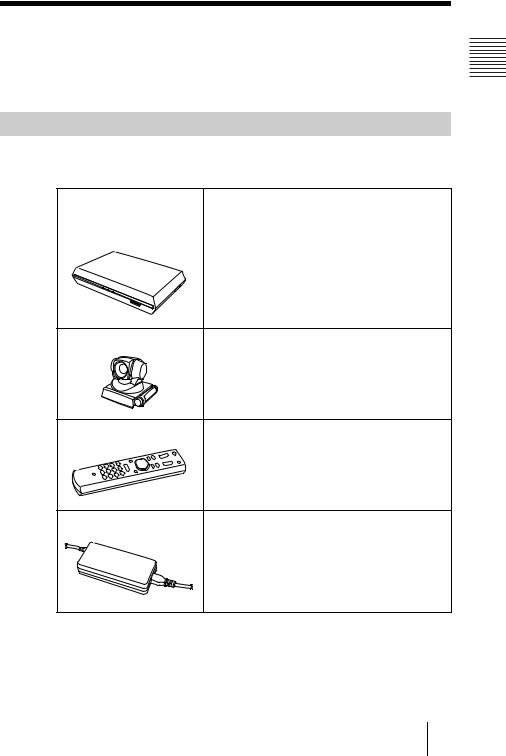
System Components
The PCS-1/1P Video Communication System is composed of basic system components for a basic videoconference, and optional equipment for an enhanced videoconference.
Basic System Components
The PCS-1/1P Video Communication System is the basic system of the PCS- 1/1P Videoconferencing System. It contains the following components:
Unit |
Description |
PCS-P1/P1P Communication |
Contains the video codec, audio codec, echo |
Terminal |
canceler, network interfaces and system controller. |
PCS-C1/C1P Camera Unit |
Composed of the camera and an integrated |
|
microphone. |
PCS-R1 Remote Commander Used to operate the Communication Terminal and Camera Unit.
PCS-AC195 AC adaptor |
Supplies power to the Communication Terminal. |
Preparation and Installation 1: Chapter
System Components 11
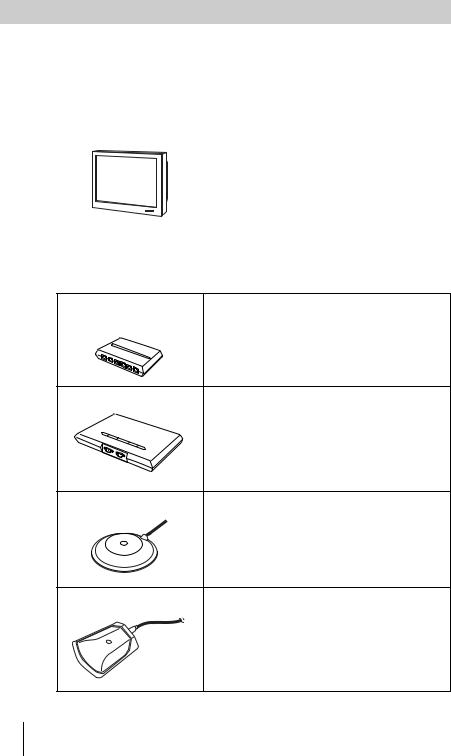
Optional Equipment
TV monitor
A TV or projector, etc. is required to monitor the images for videoconferencing system.
|
Unit |
Description |
|
|
|
|
TV, Projector, etc. |
Used as a monitor and speakers. |
|
|
|
|
|
|
Optional equipment especially designed for use with the PCS-1/1P
The following optional devices are used to enhance your videoconference.
Unit |
Description |
PCS-B768 ISDN Unit |
Used to connect to an ISDN line. Up to six ISDN |
|
lines; 12B channels usable. |
PCS-DSB1 Data Solution Box Use of this device allows easy connection with a computer or projector for a data conference.
PCS-A1 Microphone |
Omni-directional microphone that picks up sound |
|
relatively from all directions, allowing participants to |
|
speak from any location. It is recommended to use in |
|
a quiet situation. |
PCS-A300 Microphone |
Unidirectional microphone. It is recommended when |
|
you want to pick up the voice of a speaker directed |
|
toward the microphone. |
12 System Components
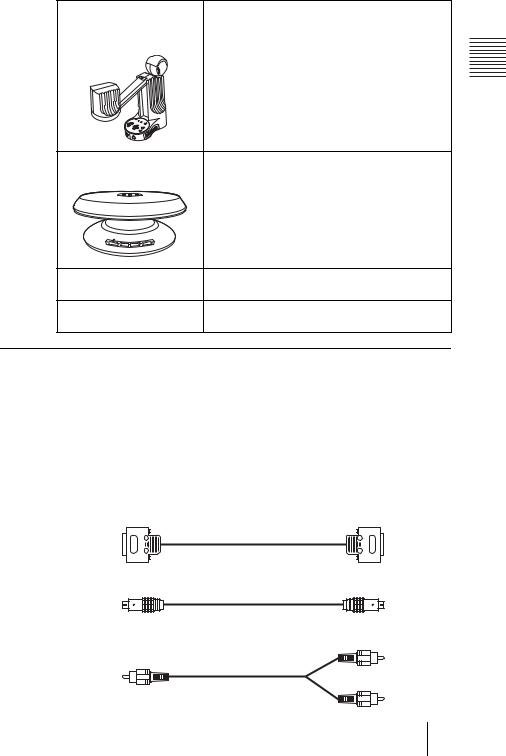
Unit |
Description |
PCS-DS150/DS150P |
Allows transmission of pictures to the |
Document Stand |
Communication Terminal by infrared signals without |
|
connecting a cable. |
CTE-600 Communication |
Integrated microphone/speaker system suitable for |
Transducer |
remote communication. The uni-directional |
|
microphones pick up clear voice with minimum |
|
background noise. |
|
Moreover, the omni-directional speaker outputs |
|
sound equally in all directions. |
PCS-323M1 H.323 MCU |
Allows use for a multipoint videoconference over |
Software |
LAN connection. |
PCS-320M1 H.320 MCU |
Allows use for a multipoint videoconference over |
Software |
ISDN connection. |
Connecting cables
Use the following connecting cables to connect devices in this system.
PCS-1/1P Video Communication System
Cable |
Part No. |
Number |
|
|
|
Camera cable (0.25 m (0.8 feet)) |
1-827-376-11 |
1 |
|
|
|
S-video connecting cable (1.5 m (4.9 feet)) |
1-776-078-42 |
1 |
|
|
|
Audio connecting cable (1 m (3.3 feet)) |
1-765-258-31 |
1 |
|
|
|
Camera cable
S-video connecting cable
Audio connecting cable
Preparation and Installation 1: Chapter
System Components 13
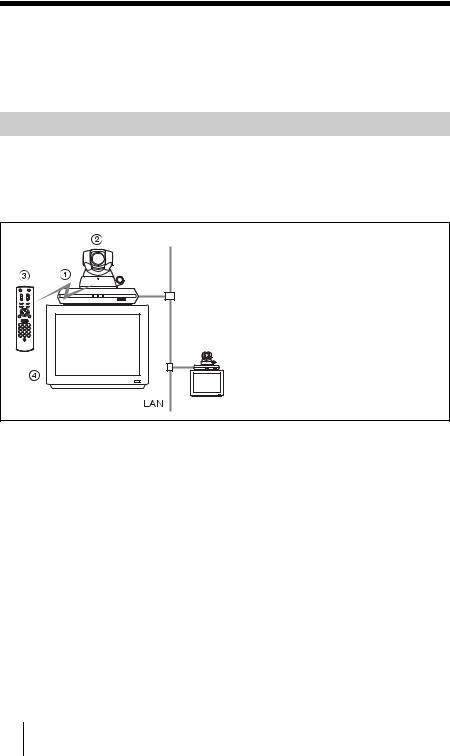
System Configuration
The PCS-1/1P Video Communication System has various system configuration capabilities using the basic components and optional equipment. This section describes seven typical examples.
System Configuration via a LAN
This allows you:
•To hold a point-to-point videoconference over LAN.
•To show still images stored in a “Memory Stick”.
System configuration
1 PCS-P1/P1P Communication Terminal
2 PCS-C1/C1P Camera Unit
3 PCS-R1 Remote Commander
4 TV monitor (not supplied)
14 System Configuration
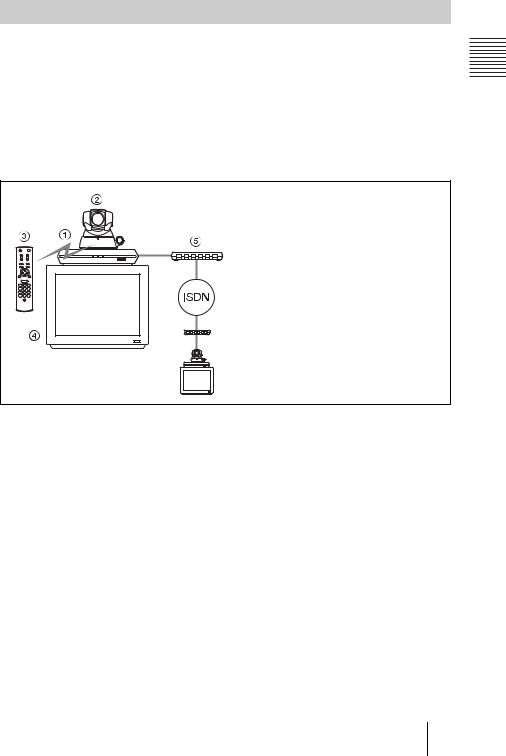
System Configuration via an ISDN
Connection to ISDN is required to use the PCS-B768 ISDN Unit especially designed for use with this system.
This allows you:
•To hold a point-to-point videoconference over ISDN.
•To show still images stored in a “Memory Stick”.
•To hold a videoconference with high speeds and highest quality image transmission by connecting up to six ISDN lines.
System configuration
1 PCS-P1/P1P Communication Terminal
2 PCS-C1/C1P Camera Unit
3 PCS-R1 Remote Commander
4 TV monitor (not supplied)
5 PCS-B768 ISDN Unit (not supplied)
About the number of ISDN lines and B (bearer) channel
Up to six ISDN lines can be connected to one PCS-1/1P via the optional PCSB768 ISDN Unit. Each ISDN line is composed of two B channels that carry data signals on the ISDN interface, enabling both channels to be used for one ISDN line connection (2B connection), or each for a separate ISDN line connection (1B connection). The more channels you use for a single communication, the faster speeds and higher-quality picture you can obtain for your network communication. You can connect up to six ISDN lines with the PCS-1/1P and select the number of channels used for a single communication among from 1B, 2B, 3B, 4B, 5B, 6B, 8B and 12B connections.
Preparation and Installation 1: Chapter
System Configuration 15
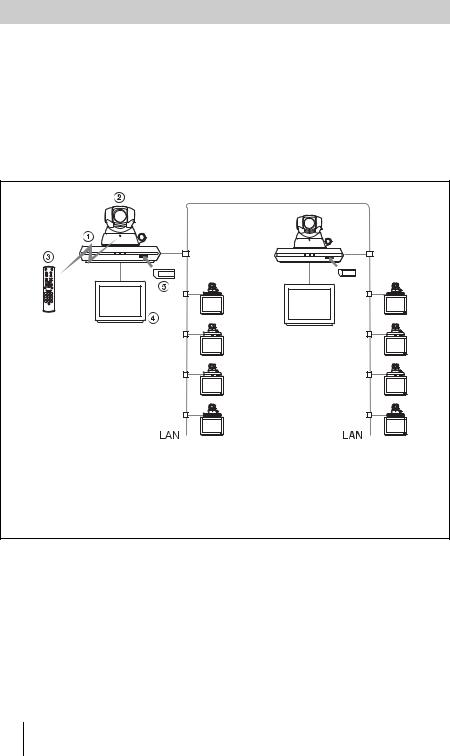
System Configuration via a LAN for Multipoint Conference
You need to install the optional PCS-323M1 H.323 MCU software.
This allows you:
•To hold a multipoint videoconference among up to ten sites over LAN.
•To show still images stored in a “Memory Stick”.
•To show the still images on the second TV monitor or projector.
•To pick up a large number of participants’ voices using up to two external microphones.
System configuration
1 PCS-P1/P1P Communication Terminal
2 PCS-C1/C1P Camera Unit
3 PCS-R1 Remote Commander
4 TV monitor (not supplied)
5 PCS-323M1 H.323 MCU software (not supplied)
16 System Configuration
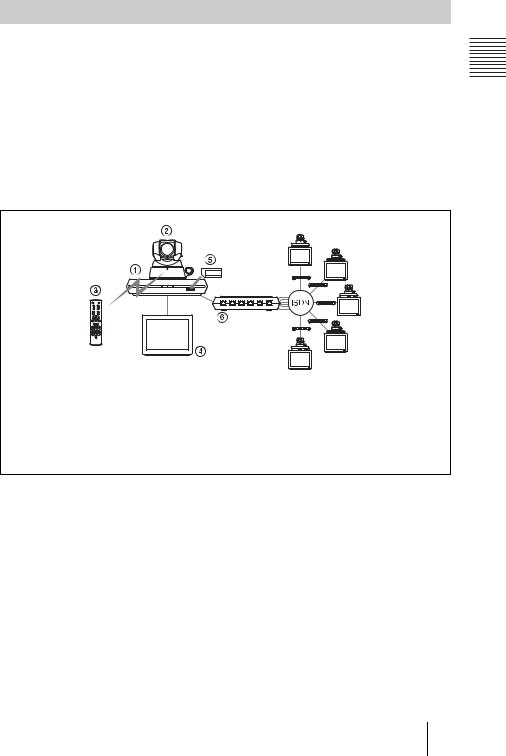
System Configuration via an ISDN for Multipoint Conference
You need to connect the optional PCS-B768 ISDN Unit especially designed for use with this System and to install the optional PCS-320M1 H.320 MCU software.
This allows you:
•To hold a multipoint videoconference among up to six sites over ISDN.
•To show still images stored in a “Memory Stick”.
•To show the still images on the second TV monitor or projector.
•To pick up a large number of participants’ voices using up to two external microphones.
System configuration
1 |
2 |
3 |
4 |
5 |
6 |
1 PCS-P1/P1P Communication Terminal
2 PCS-C1/C1P Camera Unit
3 PCS-R1 Remote Commander
4 TV monitor (not supplied)
5 PCS-320M1 H.320 MCU software (not supplied)
6 PCS-B768 ISDN Unit (not supplied)
Preparation and Installation 1: Chapter
System Configuration 17
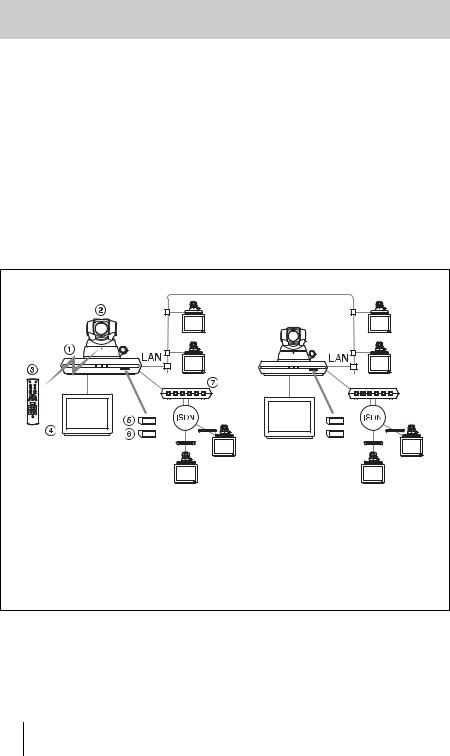
System Configuration via a LAN and ISDN for Multipoint Conference
Installing the optional PCS-323M1 H.323 MCU software (for LAN) and PCS320M1 H.320 MCU software (for ISDN) enables conduct of a multipoint conference via a LAN and ISDN mixed.
Two Communication Terminals in which MCU software is installed must be connected via a LAN.
This allows you:
•To hold a multipoint videoconference among up to ten sites over LAN and ISDN.
•To show still images stored in a “Memory Stick”.
•To show the still images on the second TV monitor or projector.
•To pick up a large number of participants’ voices using up to two external microphones.
System configuration
LAN*
1 PCS-P1/P1P Communication Terminal
2 PCS-C1/C1P Camera Unit
3 PCS-R1 Remote Commander
4 TV monitor (not supplied)
5 PCS-323M1 H.323 MCU software (not supplied)
6 PCS-320M1 H.320 MCU software (not supplied)
7 PCS-B768 ISDN Unit (not supplied)
*Be sure to make a connection via LAN.
18 System Configuration
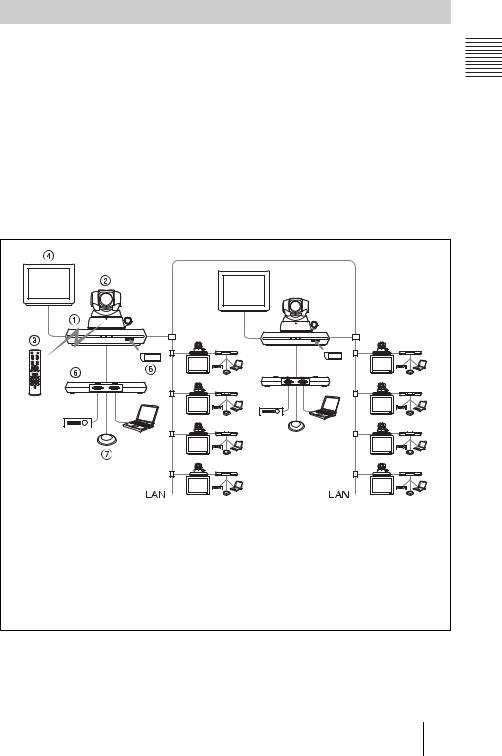
System Configuration via a LAN for Multipoint Data Conference
You need to connect the optional PCS-DSB1 Data Solution Box especially designed to use with this System and to install the optional PCS-323M1 H.323 MCU software.
This allows you:
•To hold a multipoint videoconference among up to ten sites over LAN.
•To show still images stored in a “Memory Stick”.
•To use the data from a computer or external equipment.
•To show the data from a computer or still images on the second TV monitor or projector.
•To pick up a large number of participants’ voices using up to five external microphones connected to the Data Solution Box.
System configuration
1 PCS-P1/P1P Communication Terminal
2 PCS-C1/C1P Camera Unit
3 PCS-R1 Remote Commander
4 TV monitor (not supplied)
5 PCS-323M1 H.323 MCU software (not supplied)
6 PCS-DSB1 Data Solution Box (not supplied)
7 PCS-A1 Microphone (not supplied)
Preparation and Installation 1: Chapter
System Configuration 19
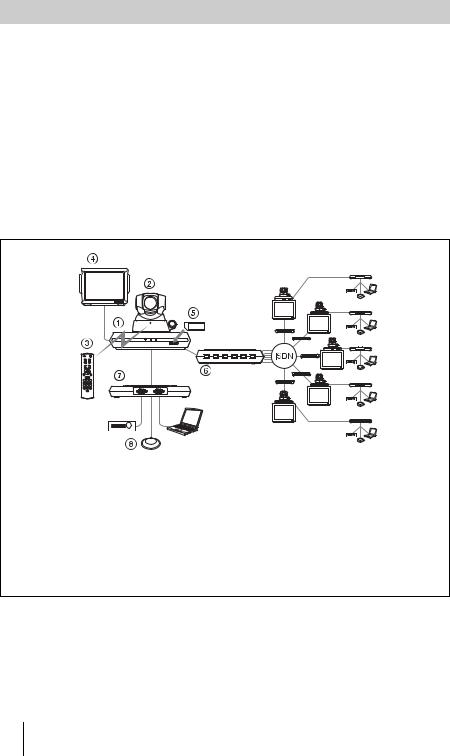
System Configuration via an ISDN for Multipoint Data Conference
You need to connect the optional PCS-B768 ISDN Unit and the PCS-DSB1 Data Solution Box especially designed for use with this System and to install the optional PCS-320M1 H.320 MCU software.
This allows you:
•To hold a multipoint videoconference among up to six sites over ISDN.
•To show still images stored in a “Memory Stick”.
•To use the data from a computer or an external equipment.
•To show the data from a computer or still images on the second TV monitor or projector.
•To pick up a large number of participants’ voices using up to five external microphones connected to the Data Solution Box.
System configuration
1 |
2 |
3 |
4 |
5 |
6 |
1 PCS-P1/P1P Communication Terminal
2 PCS-C1/C1P Camera Unit
3 PCS-R1 Remote Commander
4 TV monitor (not supplied)
5 PCS-320M1 H.320 MCU software (not supplied)
6 PCS-B768 ISDN Unit (not supplied)
7 PCS-DSB1 Data Solution Box (not supplied)
8 PCS-A1 Microphone (not supplied)
20 System Configuration

System Connections
This section describes the typical system connections.
Notes
•Be sure to turn off all the equipment before making any connections.
•Do not connect/disconnect the camera cable with the power on. Doing so may damage the Camera Unit or Communication Terminal.
•For safety, do not connect the 100BASE-TX/10BASE-T connector to a network that applies an excess voltage via the 100BASE-TX/10BASE-T connector.
System Connection via a LAN
PCS-C1/C1P Camera Unit
TERMINAL VISCA OUT
|
|
|
to TERMINAL |
|
|
PCS-P1/P1P |
|
Camera cable* |
|
||
|
|
|
|
||
Communication |
|
to CAMERA UNIT |
|||
Terminal |
|
|
|||
AUDIO OUT |
AUX1–VIDEO IN–AUX2 |
AUDIO IN CAMERA UNIT |
MIC |
|
|
|
|
|
(PLUG IN POWER) ISDN UNIT |
WHITE |
|
|
|
|
1 |
2 |
BOARD |
(MIXED) |
|
|
|
DC 19.5V |
|
VIDEO OUT |
|
100BASE-TX |
|
||
AUX MAIN– MONITOR– SUB |
RGB OUT |
10BASE-T |
DSB |
|
|
|
|
IR OUT |
|
|
|
|
|
1 |
2 |
|
|
|
|
|
|
|
to DC19.5V |
to AUDIO |
to VIDEO |
|
|
Power cord* |
|
OUT |
OUT |
|
to 100BASE-TX/ |
||
|
MONITOR |
||||
|
MAIN |
10BASE-T |
to a wall outlet |
||
|
PCS-AC195 |
||||
|
|
|
|
|
|
|
|
|
|
|
AC adaptor |
|
S-video |
|
UTP cable (category 5, straight)** |
||
|
|
|
|
||
Audio |
connecting |
|
|
to LAN |
|
cable* |
|
|
|||
connecting |
|
|
|||
|
|
|
|
|
|
cable* |
to S-video |
|
|
|
|
|
|
|
|
||
|
|
input |
|
|
TV monitor** |
|
|
|
|
|
|
* supplied |
to audio input |
|
|
to a wall outlet |
|
|
|
|
|
|
|
** not supplied
Preparation and Installation 1: Chapter
System Connections 21
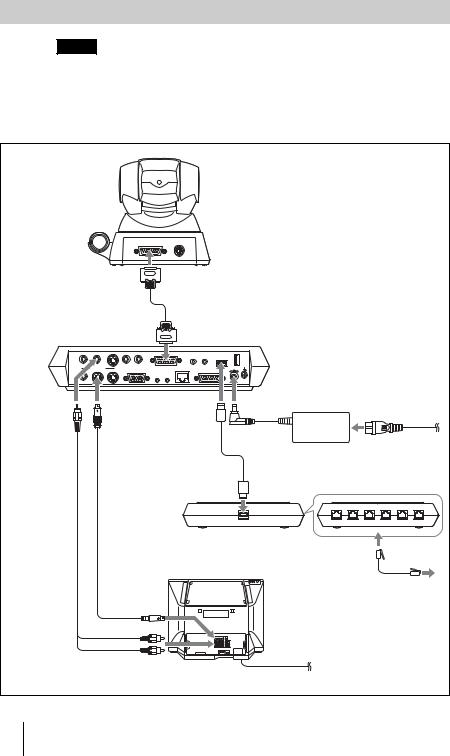
System Connection via an ISDN
Notes
• Do not connect/disconnect the camera cable or the interface cable with the power on. Doing so may damage the Camera Unit, Communication Terminal or ISDN Unit.
• Used with the PCS-B768 ISDN Unit for the first time, the Communication Terminal may automatically upgrade the software of the ISDN Unit. While the upgrading message is displayed on the monitor screen, be sure not to turn off the Communication Terminal. Doing so may cause malfunction of the system.
|
|
|
|
|
PCS-C1/C1P Camera Unit |
|
|
|
|
|
||
|
|
|
TERMINAL |
VISCA OUT |
|
|
|
|
|
|
|
|
|
|
|
|
to TERMINAL |
|
|
|
|
|
|
|
|
|
PCS-P1/P1P |
|
Camera cable* |
|
|
|
|
|
|
|
||
|
|
|
|
|
|
|
|
|
|
|
||
|
Communication |
|
to CAMERA UNIT |
|
|
|
|
|
|
|||
|
Terminal |
|
|
|
|
|
|
|
|
|||
|
AUDIO OUT |
AUX1–VIDEO IN–AUX2 |
AUDIO IN CAMERA UNIT |
MIC |
|
|
|
|
|
|
|
|
|
|
|
|
(PLUG IN POWER) ISDN UNIT |
WHITE |
|
|
|
|
|
|
|
|
|
|
|
1 |
2 |
BOARD |
|
|
|
|
|
|
|
(MIXED) |
|
|
|
DC 19.5V |
|
|
|
|
|
|
|
|
VIDEO OUT |
|
100BASE-TX |
|
|
|
|
|
|
|
||
|
AUX MAIN– MONITOR– SUB |
RGB OUT |
10BASE-T |
DSB |
|
|
|
|
|
|
|
|
|
|
|
IR OUT |
|
|
|
|
|
|
|
|
|
|
|
|
1 |
2 |
|
|
|
|
|
|
|
|
|
|
|
|
to ISDN |
to DC19.5V |
|
|
|
|
|
|
|
|
to AUDIO |
to VIDEO |
|
|
|
|
Power cord* |
|||||
|
UNIT |
|
|
|
|
|||||||
|
OUT |
OUT |
|
|
|
|
|
|
|
|
||
|
|
|
|
|
|
|
|
|
|
|
||
|
|
MONITOR |
|
|
|
|
|
to a wall outlet |
||||
|
|
MAIN |
|
|
PCS-AC195 |
|
||||||
|
|
|
|
|
|
|
|
|
||||
|
|
|
|
Interface cable |
|
|
|
|
|
|||
|
|
|
|
AC adaptor |
|
|
|
|
|
|||
|
|
(supplied with the PCS-B768) |
to |
|
|
|
|
|
|
|||
|
|
|
|
|
|
Front |
|
|
|
|
||
|
|
|
|
|
|
TERMINAL |
|
|
|
|
||
|
|
|
|
|
|
|
|
|
|
|
|
|
|
|
|
|
|
|
|
1 |
2 |
3 |
4 |
5 |
6 |
|
|
S-video |
|
|
|
|
|
|
|
|
|
|
|
|
connecting |
|
PCS-B768 ISDN Unit** |
|
|
|
|
|
|
||
|
Audio |
cable* |
|
to ISDN 1-6 |
|
|
|
|||||
|
|
|
|
|
|
|
||||||
|
|
|
|
|
|
|
|
|
|
|
|
|
|
connecting |
|
|
|
|
|
ISDN modular |
|
to ISDN |
|||
|
cable* |
|
|
TV monitor** |
|
|||||||
|
|
|
|
|
|
|||||||
|
|
|
|
|
|
|
|
cable** |
|
|
|
|
|
|
to S-video |
|
|
|
|
|
|
|
|
|
|
|
|
|
input |
|
|
|
|
|
|
|
|
|
* |
supplied |
to audio input |
|
|
|
to a wall outlet |
|
|
||||
|
|
|
|
|
|
|
|
|
|
|
||
** not supplied |
|
|
|
|
|
|
|
|
|
|
|
|
22 |
System Connections |
|
|
|
|
|
|
|
|
|
|
|
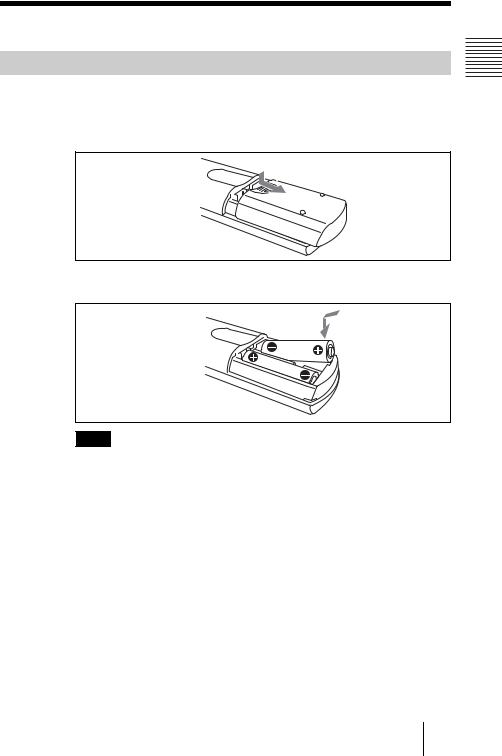
Preparing the System
Inserting Batteries into the Remote Commander
Most of the operations with the Video Communication System can be controlled with the supplied Remote Commander.
1 Remove the battery compartment cover.
2 Insert two size AA (R6) batteries (supplied) with correct polarities into the battery compartment.
Note
Be sure to insert the batteries E side first. Inserting them forcibly e side first may damage the insulated film covering the batteries and cause a short circuit.
3 Replace the cover.
Battery life
When the Remote Commander does not function properly, replace both the batteries with new ones.
Notes on batteries
To avoid damage from possible battery leakage or corrosion, observe the following:
•Make sure to insert the batteries with the polarities in the correct direction.
•Do not mix old and new batteries, or different types of batteries.
•Do not attempt to charge the batteries.
•If you do not intend to use the Remote Commander for a long period of time, remove the batteries.
•If battery leakage occurs, clean the battery compartment and replace all the batteries with new ones.
Preparation and Installation 1: Chapter
Preparing the System 23
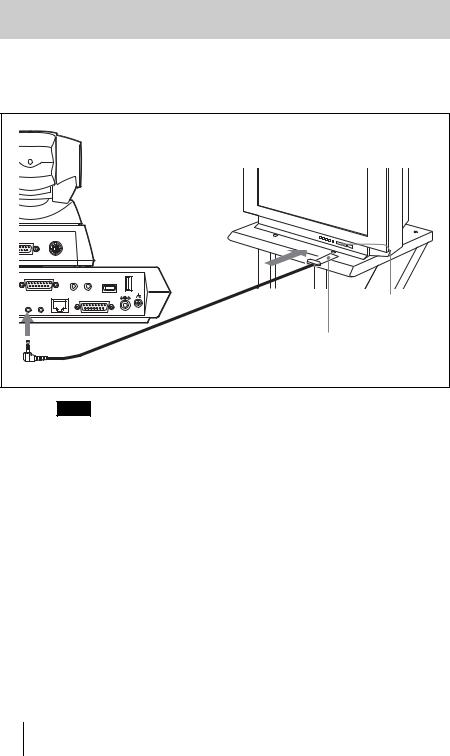
Turning On/Off the TV Monitor Together With the Communication
Terminal
If you use a Sony TV, insert the IR repeater under the remote sensor of the TV. Once you set the IR repeater, the TV will turn on or go to standby together with the Communication Terminal when you press the "/1 button on the supplied Remote Commander.
|
|
|
|
TV monitor |
CAMERA UNIT |
MIC |
ISDN UNIT |
WHITE |
|
|
(PLUG IN POWER) |
|||
|
1 |
2 |
|
BOARD |
|
100BASE-TX |
|
|
DC 19.5V |
|
10BASE-T |
|
DSB |
Remote sensor |
|
|
|
||
|
IR OUT |
|
|
|
1 |
2 |
|
|
|
|
|
|
|
IR repeater (supplied) |
to IR OUT |
|
|
|
|
|
Note |
|
|
|
If the TV monitor is not turned on by pressing the @/1 button on the Remote Commander, change the “IR Repeater Mode” setting in the General Setup menu.
For details on the “IR Repeater Mode” setting, see “General Setup Menu” on page 49.
24 Preparing the System
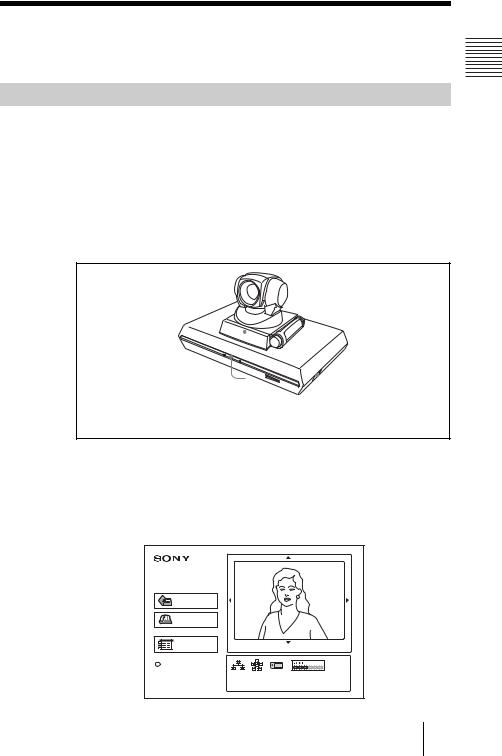
Turning the System On/Off
This section describes how to turn on or off the Communication Terminal.
Turning On
1 Turn on the TV monitor.
If the IR repeater is installed in the TV monitor, set the TV monitor to standby mode. The TV monitor will turn on simultaneously when the Communication Terminal is turned on.
2 Turn on the power of any other equipment to be used for the videoconference.
3 Set the power switch on the right side of the Communication Terminal to the on position (@).
|
|
|
|
|
|
|
|
|
|
|
|
Power switch |
||
POWER indicators |
||||
|
|
|||
(Light in green.) |
|
|
||
The Communication Terminal turns on after a while. Three indicators on the front of the Communication Terminal and the POWER indicator on the camera light, then only the POWER indicators on both units remain on in green. The launcher menu will appear on the monitor screen and the picture shot by the local camera will also appear in the launcher menu.
Launcher menu
Connect |
|
Phone Book |
|
Dial |
|
Menu |
Angle Adj. |
Press to show help |
|
IP:0.0.0.0 |
ISDN:012345678912 |
Video:Main |
Audio:MIC(INT)+AUX |
Preparation and Installation 1: Chapter
Turning the System On/Off 25

Notes
•After the power is turned on, the camera moves automatically for trial operation. Be careful not to catch your finger.
•If you use force to prevent the camera moving, it may not resume moving and not output a signal to the Communication Terminal. In this case, turn off the Terminal, and turn it on again.
•When you turn on the power of the Communication Terminal for the first time after installation, the setup wizard will appear after the self-diagnosis is completed. Set up your system following the wizard.
For setups using the wizard, see “Setting Up the System for the First Time
— Initial Setup Wizard” on page 30.
•Used with an optional device especially designed for use with this system, such as the Data Solution Box or ISDN Unit, for the first time, the Communication Terminal may automatically upgrade the software of the connected device. While the upgrading message is displayed on the monitor screen, be sure not to turn off the Communication Terminal. Doing so may cause malfunction of the system. System malfunction may also occur when a system power-off has been caused by an accidental problem such as a power interruption during upgrading. If connection of the Data Solution Box or ISDN Unit to the Communication Terminal is not re-established even after the system power is recovered, consult a Sony dealer.
Standby Mode Function
To save power the Communication Terminal will enter standby mode if you do not operate it for a specified period of time.
When the Communication Terminal is in standby mode, the POWER indicator lights in orange. Once the Communication Terminal receives a call, the standby mode is automatically released.
To release the standby mode
Press the @/1 button on the Remote Commander.
To specify the standby time
Specify the time that you want the system to remain on before entering into standby mode (1 to 99 minutes) using “Standby Time” in the General Setup menu. If you do not want the system to enter the standby mode, set “Standby Mode” in the General Setup menu to “Off”.
For the “Standby Time” and “Standby Mode” settings, see “General Setup Menu” on page 48.
Notes
•The POWER indicator on the camera goes off when the system enters standby mode.
•If you use a Sony TV monitor with the IR repeater installed under the remote sensor, the TV monitor will enter standby mode together with the Communication Terminal.
26 Turning the System On/Off
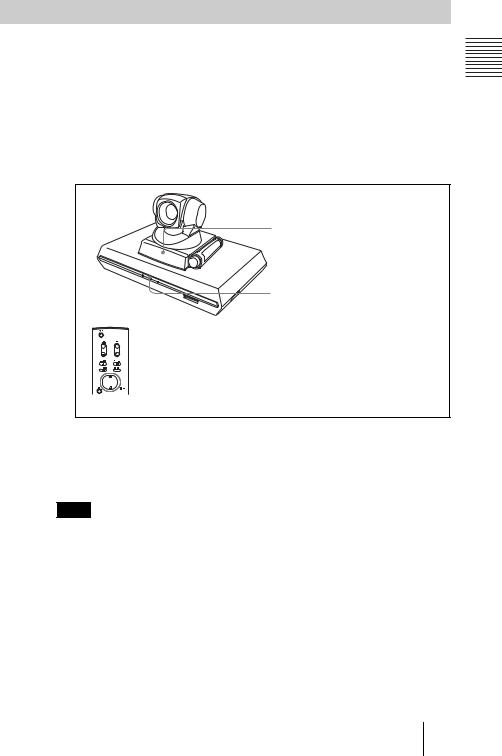
Setting the Video Communication System to Standby Mode
You can turn on the Video Communication System with the @/1 button on the Remote Commander if it is in standby mode.
1 Display the launcher menu on the monitor screen, then press the @/1 button on the Remote Commander.
The message “Power off?” appears on the monitor screen.
2 Press the B or b button on the Remote Commander to select OK, and press the PUSH ENTER button.
You may press the @/1 button on the Remote Commander.
POWER indicator (Not lit.)
POWER indicator (Lights in orange.)
 @/1 button
@/1 button



 B/b buttons and PUSH ENTER
B/b buttons and PUSH ENTER  button
button
The Video Communication System enters standby mode and the POWER indicator on the Communication Terminal lights in orange. The POWER indicator on the camera goes out.
If the IR repeater is installed in a Sony TV monitor, it will go into standby together with the Video Communication System.
Note
When the Communication Terminal and the Camera are separately installed, point the Remote Commander to the Camera for operations.
To cancel setting the system to standby
Select “Cancel” with the B or b button on the Remote Commander, then press the PUSH ENTER button in step 2 above.
Preparation and Installation 1: Chapter
Turning the System On/Off 27

Turning Off
1 Set the power switch on the right side of the Communication Terminal to the off position (a).
2 Turn off the power of other equipment used for the videoconference.
Note
Set the power switch on the Communication Terminal off when the system will not be used for an extended period. While the power switch is off, you cannot receive a call from a remote party.
Adjusting the Volume on the TV Monitor
Before adjusting the volume on the TV monitor, set the volume on the Communication Terminal to the appropriate position.
1 Press the VOLUME +/– buttons on the Remote Commander to set the volume level on the adjustment bar displayed on the screen to the middle position.
2 Adjust the volume on the TV monitor so that you can properly hear a remote party speaking.
To adjust the picture on the TV monitor
Use the controls on the TV monitor to adjust the picture, hue, contrast, brightness or sharpness.
For details on picture adjustments, refer to the Operating Instructions of the TV.
Note
Do not activate the TV’s surround sound feature as it cause strange sound since the echo canceler of the Communication Terminal does not function properly.
28 Turning the System On/Off

Displaying the Help
Pressing the HELP button on the Remote Commander displays a balloon help or a help screen to guide most operations on the monitor screen.
Note
You can hide the balloon help used for entering characters.
Press the MENU button on the Remote Commander to show the menu, select “Character Input Help” from the General Setup menu, and select “Off”. (See page 49.)
Displaying the Versions and Options
You can check the version of the Communication Terminal, versions of the connected optional equipment for exclusive use of this system, and the options installed in the Terminal by displaying the Machine Information menu on the monitor screen.
For details on the Machine Information menu, see “Machine Information Menu” on page 57.
Preparation and Installation 1: Chapter
Turning the System On/Off 29
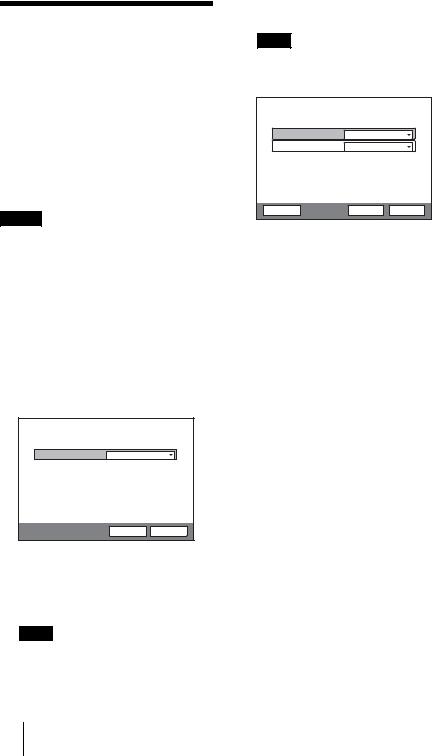
Setting Up the System for the First Time — Initial Setup Wizard
When you turn on the Communication Terminal for the first time after installation and the self-diagnosis is completed, the setup wizard appears on the monitor screen. Register your local system data with the setup wizard using the Remote Commander.
Notes
•You can change the settings made with the setup wizard later using the Setup menus.
•The setup wizard will also be displayed when you install the PCS-B768 ISDN Unit to your system later. Perform the setup again.
1 Select the language used for the onscreen menus and messages in the Language Setup Wizard.
Language: Select one of eight languages; English, French, German, Japanese, Spanish, Italian, Chinese, Portuguese.
Language Setup Wizard
Language |
English |
Next Cancel
2 Use the V, v, B or b button on the Remote Commander to select “Next”, then press the PUSH ENTER button.
The Monitor Setup Wizard appears.
Note
Set this item only when you connect two or more monitors with your System. If you connect only one monitor TV, select “Next”, then proceed to step 5.
3 Select a monitor from which signals are output.
Note
If you select a monitor from “Monitor Out”, other monitors than that you selected display no menus.
Monitor Setup Wizard |
|
|
Dual Monitor |
Off |
|
Monitor Out |
VIDEO OUT |
|
Previous |
Next |
Cancel |
Dual Monitor: When two monitors are connected to the System, select whether you use the dual monitor mode to allow displaying motion pictures on one monitor.
On: Enables the dual monitor mode. On the second monitor still images, images output from a computer or captured images from a whiteboard.
Off: Disables the dual monitor mode.
For details on the dual monitor mode, see see “Using Two Monitors – Dual Monitor” on page 111.
Monitor Out (or Sub Monitor Out):
Select the output connected to the monitor to which the signal is output. This item changes to “Sub Monitor Out” if “Dual Monitor” is set to “On”, and selects the output connected to the sub-monitor (second monitor) to which the signal is output.
RGB OUT: Outputs from the RGB OUT connector on the Communication Terminal.
RGB OUT (DSB): Outputs from the RGB OUT connector on the Data Solution Box.
VIDEO OUT: Outputs from the VIDEO OUT MONITOR MAIN or SUB connector.
For details, see “Displaying the Picture on a Projector or Monitor” on page 136.
30 Setting Up the System for the First Time — Initial Setup Wizard
